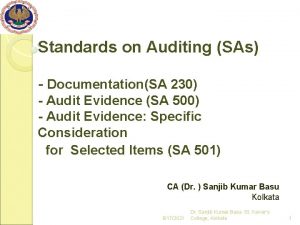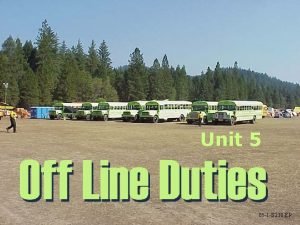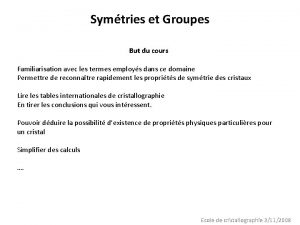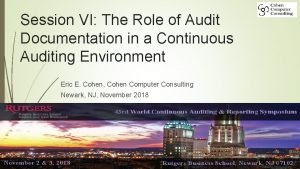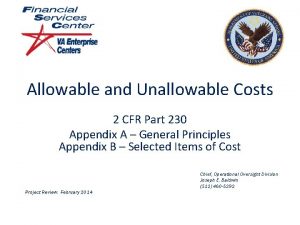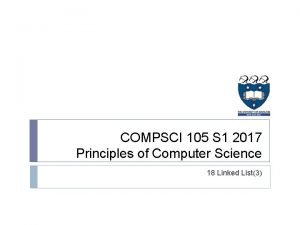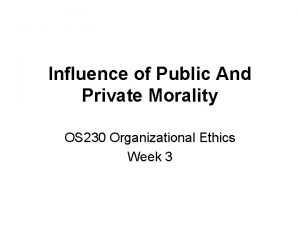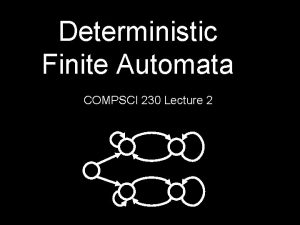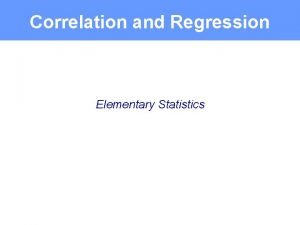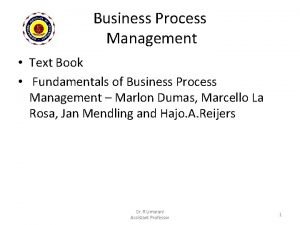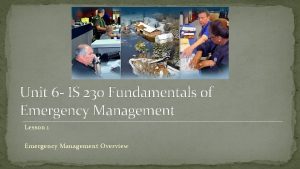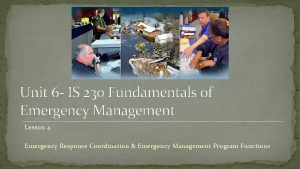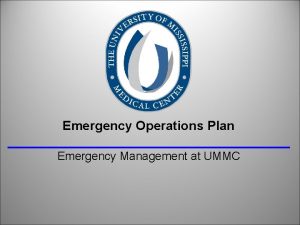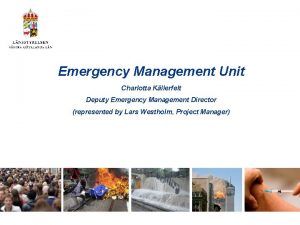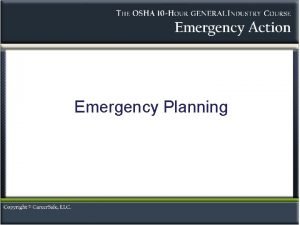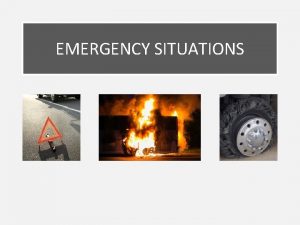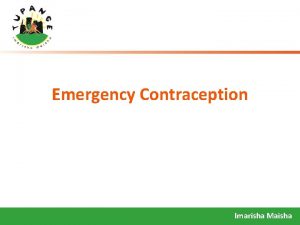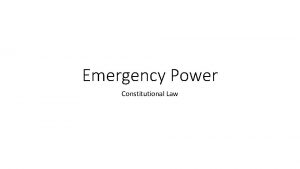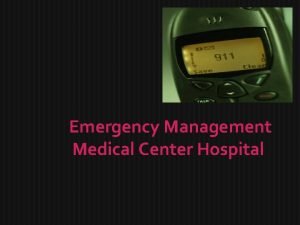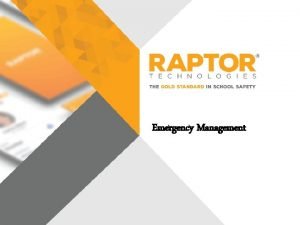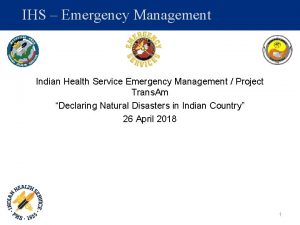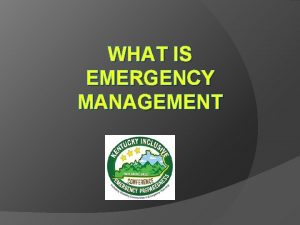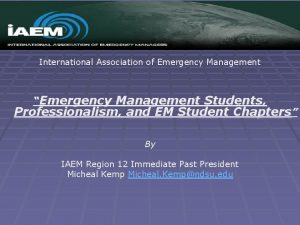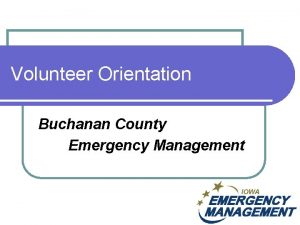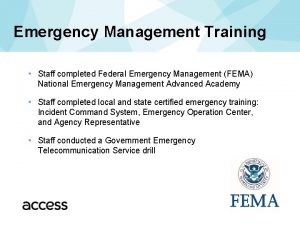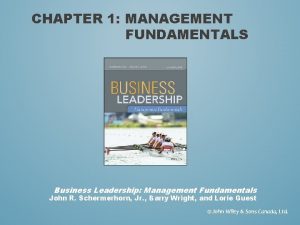Unit 6 IS 230 Fundamentals of Emergency Management






























- Slides: 30

Unit 6 - IS 230 Fundamentals of Emergency Management Lesson 3 Emergency Management Roles & Emergency Operations Plan

Lesson Overview �This lesson describes each partner’s role in more detail. At the completion of this lesson, you should be able to: � Describe the role of the local emergency manager. � Describe how private-sector and nongovernmental organizations participate in emergency management. � Describe the tribal role in emergency management. � Discuss the State’s role in emergency management. � Describe the community member role in emergency management. � Discuss the Federal role in major emergencies and disasters.

Role of Local Emergency Manager �The majority of emergencies and disasters are local and are handled locally by first responders and emergency managers. The local emergency manager has the responsibility for coordinating emergency management programs and activities, including: � Managing resources before, during, and after a major emergency or disaster. � Conducting activities related to the key components of emergency management. � Coordinating with all stakeholders in the emergency management process.

Role of Tribal Leader �The tribal leader is responsible for the public safety and welfare of the people of that tribe. As authorized by tribal government, the tribal leader can: � Coordinate tribal resources needed to prevent, protect against, mitigate against, prepare for, respond to, and recover from incidents of all types. � Amend or suspend certain tribal laws or ordinances associated with response. � Communicate with the tribal councils and community, and help people, businesses, and organizations cope with the consequences of any type of incident. � Negotiate mutual aid and assistance agreements with other tribes or jurisdictions. � Request Federal assistance under the Stafford Act through the Governor of the State or by direct request to the President when it becomes clear that the tribe’s capabilities will be insufficient or have been exceeded.

Role of State Emergency Management �The State’s role is to supplement and facilitate local efforts before, during, and after emergencies by coordinating and integrating resources and applying them to local needs. � Coordinates with local governments to meet their emergency needs. � Assesses available State and Federal resources. � Helps local governments with guidance and assistance to apply for, acquire, and use those State and Federal resources effectively.

State Roles: Governor �Within the State, the Governor has the following emergency management responsibilities: � Issues State or area emergency declarations based on the application and the damage estimates. � Initiates State response actions (personnel, materials, etc. ). � Activates emergency contingency funds and/or reallocates regular budgets for emergency activities. � Oversees emergency management. � Requests, disburses, and monitors Federal assistance. For State governments, only the Governor can request the Federal aid that comes with a Presidential declaration.

Role of the Federal Government �The Federal Government promotes the development and sustainment of capabilities across all mission areas. Assistance from the Federal Government may take the form of fiscal support, technical assistance, or information about materials, personnel resources, and research. �The Federal Government provides legislation, Executive orders, and regulations that influence all emergency management activities. It also maintains the largest pool of fiscal resources that can assist in the delivery of capabilities.

Role of the President of the United States �As the head of the executive branch of the Federal Government, the President of the United States is responsible for: � Protecting the public. � Making an emergency and/or disaster declaration upon a Governor’s request before Federal funds are released to aid disaster survivors or provide public assistance. � Making a declaration under unique authority in such circumstances as events on Federal property.

Federal Government Roles and Responsibilities �When an incident happens, roles and responsibilities need to be clearly defined. The National Response Framework includes Emergency Support Functions (ESFs) that describe the roles and responsibilities of Federal departments and agencies for a Federal response to an incident. Each ESF has: � Primary Agencies: The NRF identifies primary agencies based on authorities, resources, and capabilities. � Support Agencies: Support agencies are assigned based on resources and capabilities in a given functional area. � ESF Coordinator: The ESF coordinating agency is responsible for steady- state planning, preparedness, and other activities.

Emergency Management Functional Groups �Emergency operations centers may use the following functional groups to support field operations: � Policy Group. This is an informal and flexible grouping of experienced public officials representing State, county, and municipal governments. � Coordination Group. This group performs a staff function by coordinating the types and number of personnel and material resources deployed, providing logistical support to field units, contracting for relief of forces, and carefully monitoring both the immediate emergency situation and other threats. � Field Response Group. This group includes the fire, law enforcement, medical, military, and public works units that normally would be on the scene of the incident.

Emergency Operations Plan

Lesson Overview �This lesson presents the planning process and why it is important to develop a comprehensive emergency operations plan (EOP). At the completion of this lesson, you should be able to: � Describe the importance of an emergency operations plan (EOP). � Describe the approach to identify and assess threats and hazards. � Describe the contents of an EOP.

What Is an EOP and What Does It Do? �An EOP: � Assigns responsibility to organizations and individuals. � Sets forth lines of authority and organizational relationships and shows how all actions will be coordinated. � Describes how people and property are protected. � Identifies personnel, equipment, facilities, supplies, and other resources. � Identifies steps to address mitigation concerns during response and recovery operations. � Is flexible enough for use in all emergencies. � Helps personnel and providers operate as a team in an emergency.

Local and State EOPs �The local government EOP focuses on measures that are essential for protecting the public, because the local government is responsible for attending to the public’s emergency needs. �The State government EOP establishes the framework within which local EOPs are created and through which the Federal Government becomes involved in response, recovery, and mitigation.

National Planning System

EOP Planning Principles (1 of 2) �Planning must be community based. �Planning must include participation from all stakeholders in the community. �Planning uses a logical and analytical problem-solving process. �Planning considers all threats and hazards. �Planning should be flexible enough to address both traditional and catastrophic incidents. �Plans must clearly identify the mission and supporting goals. �Planning depicts the anticipated environment for action. �Planning does not need to start from scratch.

EOP Planning Principles (2 of 2) �Planning identifies tasks, allocates resources to accomplish those tasks, and establishes accountability. �Planning includes senior officials throughout the process. �Time, uncertainty, risk, and experience influence planning. �Effective plans tell those with operational responsibilities what to do and why to do it. �Planning is fundamentally a process to manage risk. �Planning is one of the key components of preparedness.


Developing and Maintaining EOPs


Step 1: Form a Collaborative Planning Team The steps to form a collaborative planning team include: � Identifying the core planning team. In most jurisdictions, the emergency manager provides oversight of the planning team, although other government agencies or departments may have overlapping or complementary responsibilities. The involvement of executives from member agencies or departments is critical. � Engaging the whole community. Planning that is for the whole community and involves the whole community is crucial to the success of the plan. Effectively involving the community is a challenge, but community leaders provide keen insight into the community’s needs and capabilities.


Step 2: Understand the Situation This step describes important actions and procedures needed to: �Identify the threats and hazards in the jurisdiction using the results of THIRA, follow-on assessments, and other existing information about the jurisdiction (for example, data from the local planning and zoning commission, utility providers, the U. S. Census, the chamber of commerce, etc. ). �Assess the risk associated with those threats and hazards to help the planning team decide which ones merit special attention.


Step 3: Determine Goals and Objectives Goals should clearly indicate the desired result. �Goals are broad, general statements that indicate the intended solution to problems identified by planners when identifying threats/hazards and assessing risk in the previous step. �Objectives are specific actions that lead to achieving the identified goals of the plan. Objectives will be translated to activities and procedures.


Step 4: Plan Development and Step 5: Plan Preparation, Review, and Approval �Steps 4 and 5 are the process of developing a plan for your jurisdiction and having it reviewed, approved, and disseminated. A traditional plan has three components: the basic plan, supporting annexes, and threat/hazard/incident-specific annexes.

Basic Plan � The basic plan provides an overview of your community’s preparedness and response strategies. It describes expected threats/hazards, outlines roles and responsibilities, and explains how the plan is kept current. The contents of the basic plan include: � Introductory Material � Purpose, Scope, Situation Overview, and Assumptions � Concept of Operations � Organization and Assignment of Responsibilities � Direction, Control, and Coordination � Information Collection, Analysis, and Dissemination � Communications � Administration, Finance, and Logistics � Plan Development and Maintenance � Authorities and References


Step 6: Plan Implementation and Maintenance �The last step in the planning process is plan implementation and maintenance. Plans must not be placed on a shelf to collect dust; they must be maintained, and the information communicated to: � Local, tribal, State, and Federal officials who need to coordinate the plan with their EOPs. � Response personnel both inside and outside of the community who share responsibility for implementing the plan, reducing damage, and saving lives. � The local community, which has expectations concerning the government’s role in an emergency and, collectively, is critical to the plan’s success.
 Sa 230
Sa 230 Kvalitativa variabler
Kvalitativa variabler 254 hangi onluğa yuvarlanır
254 hangi onluğa yuvarlanır Reglamento loei
Reglamento loei S-230 crew boss quizlet
S-230 crew boss quizlet Représentation des 230 groupes d'espace
Représentation des 230 groupes d'espace Représentation des 230 groupes d'espace
Représentation des 230 groupes d'espace Difference between pcaob as 1215 and isa 230
Difference between pcaob as 1215 and isa 230 Code quest lockheed martin
Code quest lockheed martin 2 cfr 230
2 cfr 230 Zodiac cadet fastroller
Zodiac cadet fastroller Dkb 230
Dkb 230 Msb 230
Msb 230 Duke cs 230
Duke cs 230 Pengertian satuan sudut
Pengertian satuan sudut Edu 230
Edu 230 Dermatology case presentation
Dermatology case presentation Compsci 230 duke
Compsci 230 duke Sci 230
Sci 230 Compsci 230 review
Compsci 230 review Os 230
Os 230 Vodafone infodok 230
Vodafone infodok 230 Mymajorhealth
Mymajorhealth Section 230-240 of companies act 2013
Section 230-240 of companies act 2013 Compsci 230 duke
Compsci 230 duke 230-220 x 1/2
230-220 x 1/2 Compsci 230
Compsci 230 Unit 6 review questions
Unit 6 review questions Unit 1 fundamentals of it
Unit 1 fundamentals of it Unit 1 fundamental skills
Unit 1 fundamental skills Fundamentals of business process management
Fundamentals of business process management
